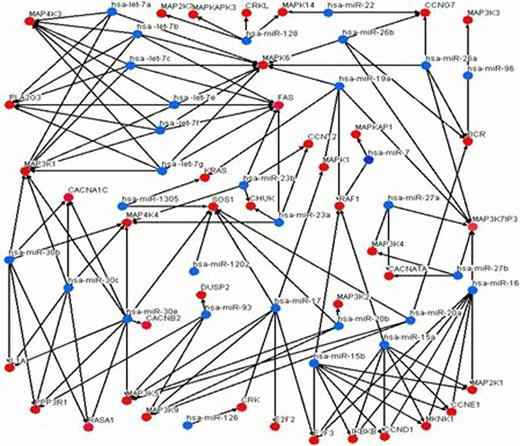Abstract
Abstract 2786
Leukemia-cell-derived microvesicles (MVs) act as vehicles for exchange of genetic information between leukemia and nomal cells, engendering a favorable microenvironment for leukemia development. Within the leukemia mass, all cell types may contribute to MV shedding, but specific contributions to tumor progression have yet to be established. MVs contain microRNAs that could be transferred to target cells inducing epigenetic changes. MicroRNAs are short non-coding regulatory RNAs that control gene expression and play an important role in cancer development and progression. However, little is known about the role of miRNAs in chronic myeloid leukemia (CML)-derived MVs. Given the attributes of MVs and microRNAs in leukemia progression, we therefore aimed to investigate a possible regulatory effect of microRNAs upon MVs as a mean to uncover molecular events involved in promotion of leukemogenesis by MVs.
Hnece, we determined the miRNA expression profiles of CML-derived MVs and their parental cells using Agilent miRNA microarray analysis. The six miRNAs obtained by microarray profiling were validated using real-time PCR. The potential targets of the differentially expressed microRNAs were predicted using computational searches. Bioinformatic analyses of the predicted target genes were done for further research.
We identified 104 microRNAs aberrantly expressed in both CML-derived MVs and their parental cells, indicating that CML-derived MVs miRNA is the mini version of the parental cells. Target gene-related pathway analyses showed that majority of the 104 microRNAs involved in the signaling pathways associated with leukemia, especially the mitogen-activated protein kinase (MAPK) signaling pathways. We found 34 microRNAs targeted 44 genes of the MAKP pathway, suggesting that the MAPK signaling pathway may commonly function together.
By further conducting microRNA gene network analysis, we found that the miR-15a/b, miR-16, miR-17and miR-30 families are likely to play key roles in the regulation of MAPK pathways. The figure showed microRNA-gene interaction networks related to the pathway. The has-miR-30 family (except for hsa-miR-30a hsa-miR-30d) showed that the most target mRNAs, with degrees from 6 to 9, while hsa-miR-17, hsa-miR-16 and hsa-miR-15a/b occupy an important position in the MAPK pathway. The seven microRNAs might play an important role in the pathogenesis of CML.
The MAPK pathway is a common point of convergence of many different mitogenic and anti-apoptotic signal transduction pathways in hematopoietic, as well as epithelial, cancer cells and can now be clinically targeted by highly selective small molecule inhibitors. Such deregulation of MAPK pathways contributes to BCR-ABL leukemogenesis, and their targeting with selective inhibitors provides an approach to enhance anti-leukemic responses and/or overcome leukemic cell resistance in CML. A large body of evidence has established that RAS/MAPK signaling contribute to the survival of BCR-ABL positive cells under imatinib selection pressure. It is evident that release of microRNAs from the lumen of MVs can induce activation of specific signal transduction cascades and influence the physiologic state of recipient cells. So the MVs derived from leukemia cells may weaken or enhance the expression of mRNA involved in MAPK pathway in recipient cells, and come to remodel the leukemia niche.
In conclusion, we first demonstrated that CML-MVs were enriched with expression changes of distinct sets of miRNAs regulating MAPK sinaling pathway. MAPK sinaling pathway were active in CML-MVs and may commonly function together. We believe that this new correlation among MVs, microRNAs and MAPK pathway can be exploited to both better understand leukemia progression and also suggest novel therapies for leukemias.
microRNA-gene interaction networks of MAPK pathway. Blue nodes represent microRNA co-eppressed in MVs from K562 cells and K562 cells, red nodes represent target mRNA. Edges show the regulatory effect of microRNA on mRNA.
microRNA-gene interaction networks of MAPK pathway. Blue nodes represent microRNA co-eppressed in MVs from K562 cells and K562 cells, red nodes represent target mRNA. Edges show the regulatory effect of microRNA on mRNA.
No relevant conflicts of interest to declare.
Author notes
Asterisk with author names denotes non-ASH members.


